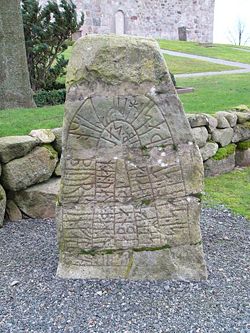Sjörup Runestone
| Sjörup Runestone | |
|---|---|
 |
|
| Rundata ID | DR 279 |
| Country | Sweden |
| Region | Skåne |
| City/Village | Sjörup |
| Produced | c. 1000 AD |
| Runemaster | Unknown |
|
Text – Native |
|
| Old Norse:See article | |
| Text – English | |
| See article | |
| Other resources | |
|
Runestones – Runic alphabet Runology – Runestone styles |
|
The Sjörup Runestone is a runestone in Scania, Sweden, from approximately 1000 AD that is classified as being in runestone style RAK.
The Sjörup Runestone has been known by scholars since the 1620s when Jon Skonvig depicted it for Ole Worm's work on Danish runestones. Two centuries later, it was blown into six pieces to be reused as building material for a bridge. However, in the mid-1990s, the pieces were removed from the bridge and reassembled, and the repaired runestone was raised anew near the church of Sjörup.
The inscription begins on the bottom right and goes counter-clockwise around the runestone until it reaches the bottom left, and then it changes direction and goes below the first row, and finally it changes direction again until it finishes in the centre of the stone. The band principally follows the convolutions of a snake.
The runestone has some points in common with the runestone DR 295. Both runestones contain dotted k-runes and both runestones use the nasal ã-rune, although the Sjörup Runestone uses the ã-rune much more and has different orthography. For instance, the Old Norse word ægi ("not") is spelled aigi on the Hällestad Runestone while this stone spells it aki. The runemaster of this runestone drops the h-rune twice in the words han ("he") and hafði ("had"), but oddly, he adds an h-rune in beginning of the word æftiʀ ("in memory of"). This vacillating orthography shows that there was an insecurity in Viking Age Scandinavia as to whether the h-phoneme should be pronounced before a vowel, and so the h-rune was sometimes absent or even added where it usually did not belong. During the same time, diphthongs turned into monophthongs and an insecurity appeared as to how to spell vowels, because the runemaster had to make a phonemic analysis of the sounds that were to be represented in the inscription.
...
Wikipedia
